Microfluidic High-Q Circular Substrate-Integrated Waveguide (SIW) Cavity for Radio Frequency (RF) Chemical Liquid Sensing
Abstract
:1. Introduction
2. Sensor Design
2.1. Circular SIW Cavity Resonator Design
2.2. PDMS Microwell Design
3. Simulation Results
4. Experimental Demonstration
5. Conclusions
Acknowledgments
Author Contributions
Conflicts of Interest
References
- Wen, G.; Wen, X.; Shuang, S.; Choi, M.M.F. Whole-cell biosensor for determination of methanol. Sens. Actuators B Chem. 2014, 201, 586–591. [Google Scholar] [CrossRef]
- Mullett, W.M.; Levsen, K.; Lubda, D.; Pawliszyn, J. Bio-compatible in-tube solid-phase microextraction capillary for the direct extraction and high-performance liquid chromatographic determination of drugs in human serum. J. Chromatogr. A 2002, 963, 325–334. [Google Scholar] [CrossRef]
- Dahlgren, R.; Van Nieuwenhuyse, E.; Litton, G. Transparency tube provides reliable water-quality measurements. Calif. Agric. 2004, 58, 149–153. [Google Scholar] [CrossRef]
- Weigl, B.H.; Yager, P. Silicon-microfabricated diffusion-based optical chemical sensor. Sens. Actuators B Chem. 1997, 39, 452–457. [Google Scholar] [CrossRef]
- White, I.M.; Oveys, H.; Fan, X. Liquid-core optical ring-resonator sensors. Opt. Lett. 2006, 31, 1319–1321. [Google Scholar] [CrossRef] [PubMed]
- Shigeki, F. Waveguide line. Japan Patent 06-053, 1994. [Google Scholar]
- Uchimura, H.; Takenoshita, T.; Fujii, M. Development of a “laminated waveguide”. IEEE Trans. Microw. Theory Tech. 1998, 46, 2438–2443. [Google Scholar] [CrossRef]
- Deslandes, D.; Wu, K. Single-substrate integration technique of planar circuits and waveguide filters. IEEE Trans. Microw. Theory Tech. 2003, 51, 593–596. [Google Scholar] [CrossRef]
- Xu, F.; Wu, K. Guided-wave and leakage characteristics of substrate integrated waveguide. IEEE Trans. Microw. Theory Tech. 2005, 53, 66–73. [Google Scholar]
- Deslandes, D.; Wu, K. Accurate modeling, wave mechanisms, and design considerations of a substrate integrated waveguide. IEEE Trans. Microw. Theory Tech. 2006, 54, 2516–2526. [Google Scholar] [CrossRef]
- Wu, K. Towards system-on-substrate approach for future millimeter-wave and photonic wireless applications. In Proceedings of the 2006 Asia-Pacific Microwave Conference (APMC), Yokohama, Japan, 12–15 December 2006; pp. 1895–1900. [Google Scholar]
- Li, Z.; Wu, K. 24-GHz Frequency-Modulation Continuous-Wave Radar Front-End System-on-Substrate. IEEE Trans. Microw. Theory Tech. 2008, 56, 278–285. [Google Scholar] [CrossRef]
- Memon, M.U.; Lim, S. Review of reconfigurable substrate-integrated-waveguide antennas. J. Electromagn. Waves Appl. 2014, 28, 1815–1833. [Google Scholar] [CrossRef]
- Memon, M.U.; Lim, S. Frequency-Tunable Compact Antenna Using Quarter-Mode Substrate Integrated Waveguide. IEEE Antennas Wirel. Propag. Lett. 2015, 14, 1606–1609. [Google Scholar] [CrossRef]
- Memon, M.U.; Ling, K.; Seo, Y.; Lim, S. Frequency-switchable half-mode substrate-integrated waveguide antenna injecting eutectic gallium indium (EGaIn) liquid metal alloy. J. Electromagn. Waves Appl. 2015, 29, 2207–2215. [Google Scholar] [CrossRef]
- Han, J.Y.; Yoon, S.S.; Lee, J.W. Miniaturization of SIW-Based Linearly Polarized Slot Antennas for Software-Defined Radar. J. Electromagn. Eng. Sci. 2016, 16, 248–253. [Google Scholar] [CrossRef]
- Memon, M.U. Effects of Metallic Caps for Liquid Metal in Substrate Integrated Waveguide Antenna. In Proceedings of the 2015 IEEE Asia Pacific Microwave Conference (APMC), Nanjing, China, 6–9 December 2015; Volume 2, pp. 2–4. [Google Scholar]
- Park, S.; Park, J. Dual-Band Gap-Filler Antenna Design with Phi-Shaped Slot. J. Electromagn. Eng. Sci. 2015, 15, 111–114. [Google Scholar]
- McDonald, J.C.; Duffy, D.C.; Anderson, J.R.; Chiu, D.T.; Wu, H.; Schueller, O.J.; Whitesides, G.M. Fabrication of microfluidic systems in poly(dimethylsiloxane). Electrophoresis 2000, 21, 27–40. [Google Scholar] [CrossRef]
- Lotters, J.C.; Olthuis, W.; Veltink, P.H.; Bergveld, P. The mechanical properties of the rubber elastic polymer polydimethylsiloxane for sensor applications. J. Micromech.Microeng. 1997, 7, 145–147. [Google Scholar] [CrossRef]
- Memon, M.U.; Lim, S. Microwave Chemical Sensor Using Substrate-Integrated-Waveguide Cavity. Sensors 2016, 16, 1829. [Google Scholar] [CrossRef] [PubMed]
- Benson, F.A.; Benson, T.M. Rectangular and circular waveguides and cavity resonators BT-Fields. In Waves and Transmission Lines; Springer: Dordrecht, The Netherlands, 1991; pp. 50–82. [Google Scholar]
- Global Harmonised System of Classification and Labelling of Chemicals. Available online: https://www.comcare.gov.au/preventing/hazards/chemical_hazards/globally_harmonised_system_of_classification_and_labelling_of_chemicals_ghs (accessed on 27 November 2017).
- Kiourti, A.; Sun, M.; He, X.; Volakis, J.L. Microwave Cavity with Controllable Temperature for In Vitro Hyperthermia Investigations. J. Electromagn. Eng. Sci. 2014, 14, 267–272. [Google Scholar] [CrossRef]
- Hwang, S.-H.; Kang, C.G.; Lee, S.-M.; Lee, M.-Q. Reconfigurable Wireless Power Transfer System for Multiple Receivers. J. Electromagn. Eng. Sci. 2016, 16, 199–205. [Google Scholar] [CrossRef]
- Wang, Y.; Yoon, K.-C.; Lee, J.C. A Frequency Tunable Double Band-Stop Resonator (BSR) with Voltage Control by Varactor Diodes. J. Electromagn. Eng. Sci. 2016, 16, 159–163. [Google Scholar] [CrossRef]
- Ali, M.A.; Cheng, M.M.-C.; Chen, J.C.-M.; Wu, C.T.M. Microwave Gas Sensor based on Graphene-loaded Substrate Integrated Waveguide Cavity Resonator. In Proceedings of the 2016 IEEE MTT-S International Microwave Symposium (IMS), San Francisco, CA, USA, 22–27 May 2016; pp. 1–4. [Google Scholar]
- Jones, T.R.; Zarifi, M.H.; Daneshmand, M. Miniaturized Quarter-Mode Substrate Integrated Cavity Resonators for Humidity Sensing. IEEE Microw. Wirel. Compon. Lett. 2017, 27, 612–614. [Google Scholar] [CrossRef]
- Pozar, D. Microwave Engineering, 4th ed.; Addison Wesley: New York, NY, USA, 1990. [Google Scholar]
- Khanna, A.P.S.; Garault, Y. Determination of Loaded, Unloaded, and External Quality Factors of a Dielectric Resonator Coupled to a Microstrip Line. IEEE Trans. Microw. Theory Tech. 1983, 31, 261–264. [Google Scholar] [CrossRef]
- Chua, L.H.; Mirshekar-Syahkal, D. Accurate and direct characterization of high-q microwave resonators using one-port measurement. IEEE Trans. Microw. Theory Tech. 2003, 51, 978–985. [Google Scholar] [CrossRef]
- Sun, E.; Chao, S. Unloaded Q measurement-the critical points method. IEEE Trans. Microw. Theory Tech. 1995, 43, 1983–1986. [Google Scholar]
- Bray, J.R.; Roy, L. Measuring the unloaded, loaded, and external quality factors of one- and two-port resonators using scattering-parameter magnitudes at fractional power levels. IEE Proc. Microw. Antennas Propag. 2004, 151, 345–350. [Google Scholar] [CrossRef]
- Seo, Y.; Memon, M.U.; Lim, S. Microfluidic Eighth-Mode Substrate-Integrated-Waveguide Antenna for Compact Ethanol Chemical Sensor Application. IEEE Trans. Antennas Propag. 2016, 64, 3218–3222. [Google Scholar] [CrossRef]
- Jiang, L.; Pau, S. Integrated waveguide with a microfluidic channel in spiral geometry for spectroscopic applications. Appl. Phys. Lett. 2007, 90, 8–11. [Google Scholar] [CrossRef]
- Ethanol Product Information. Available online: http://www.sigmaaldrich.com/catalog/product/sial/32205?lang=ko®ion=KR (accessed on 11 April 2016).
- Liu, C.; Tong, F. An SIW Resonator Sensor for Liquid Permittivity Measurements at C Band. IEEE Microw. Wirel. Compon. Lett. 2015, 25, 751–753. [Google Scholar]
- Salim, A.; Lim, S. Complementary split-ring resonator-loaded microfluidic ethanol chemical sensor. Sensors 2016, 16, 1802. [Google Scholar] [CrossRef] [PubMed]
- Cui, Y.; He, Y.; Wang, P. A Quadrature-Based Tunable Radio-Frequency Sensor for the Detection and Analysis of Aqueous Solutions. IEEE Microw. Wirel. Compon. Lett. 2014, 24, 490–492. [Google Scholar] [CrossRef] [PubMed]
- Klein, N.; Watts, C.; Hanham, S.M.; Otter, W.J.; Ahmad, M.M.; Lucyszyn, S. Microwave-to-terahertz dielectric resonators for liquid sensing in microfluidic systems. In Proceedings of the 2016 Conference on Terahertz Emitters, Receivers, and Applications VII, San Diego, CA, USA, 28–31 August 2016; Volume 9934. [Google Scholar]
- Liu, W.N. A Novel Technology for Measurements of Dielectric Properties of Extremely Small Volumes of Liquids. Int. J. Antennas Propag. 2016, 2016, 1436798. [Google Scholar] [CrossRef]
- Matvejev, V.; Zhang, Y.; Stiens, J. High performance integrated terahertz sensor for detection of biomolecular processes in solution. IET Microw. Antennas Propag. 2014, 8, 394–400. [Google Scholar] [CrossRef]
- Mendis, R.; Astley, V.; Liu, J.; Mittleman, D.M. Terahertz microfluidic sensor based on a parallel-plate waveguide resonant cavity. Appl. Phys. Lett. 2009, 95, 1–4. [Google Scholar] [CrossRef]
- Neshat, M.; Chen, H.; Gigoyan, S.; Saeedkia, D.; Safavi-Naeini, S. Whispering-gallery-mode resonance sensor for dielectric sensing of drug tablets. Meas. Sci. Technol. 2009, 21, 15202. [Google Scholar] [CrossRef]
- Rawat, V.; Dhobale, S.; Kale, S.N. Ultra-fast selective sensing of ethanol and petrol using microwave-range metamaterial complementary split-ring resonators. J. Appl. Phys. 2014, 116, 1–6. [Google Scholar] [CrossRef]
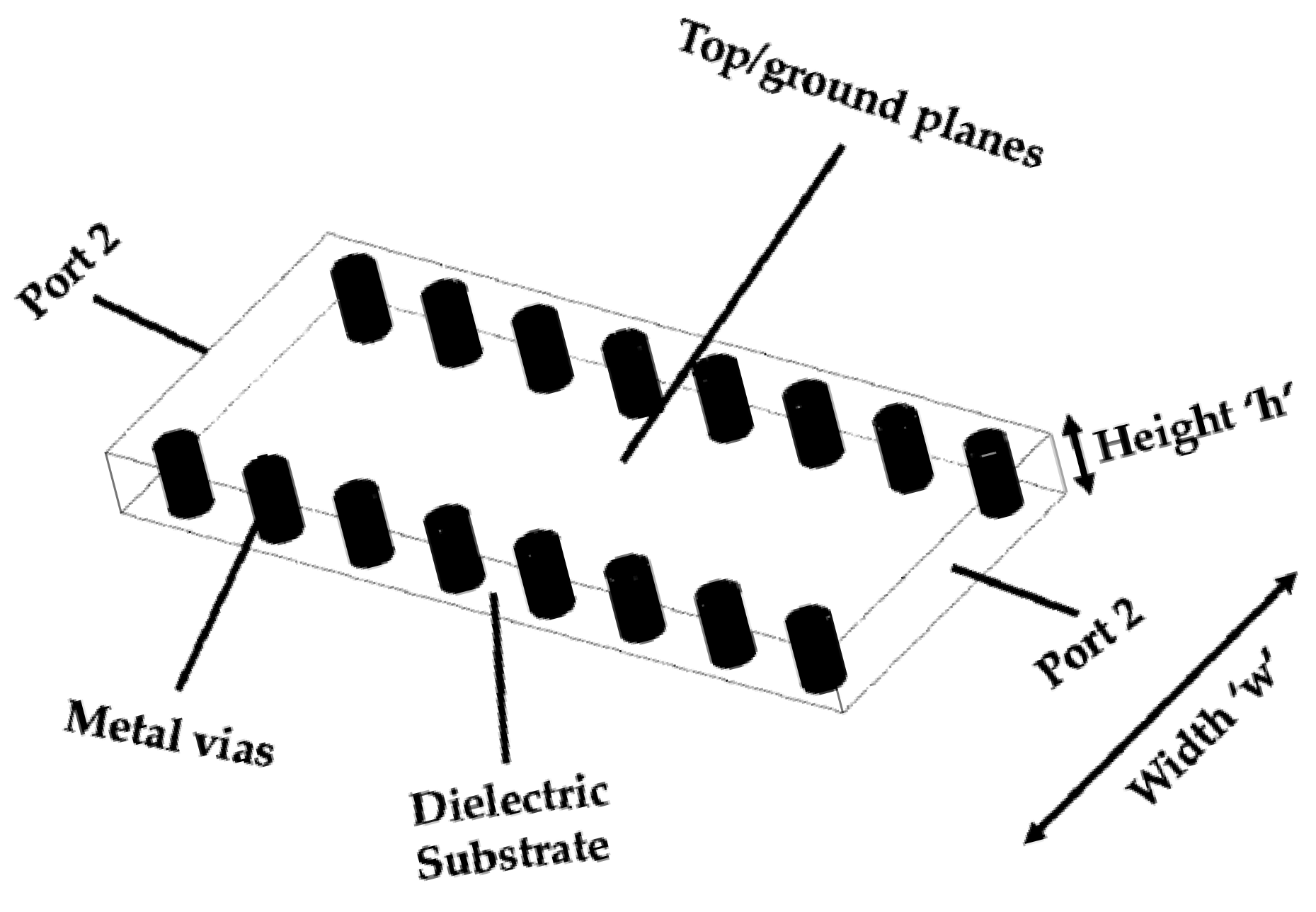
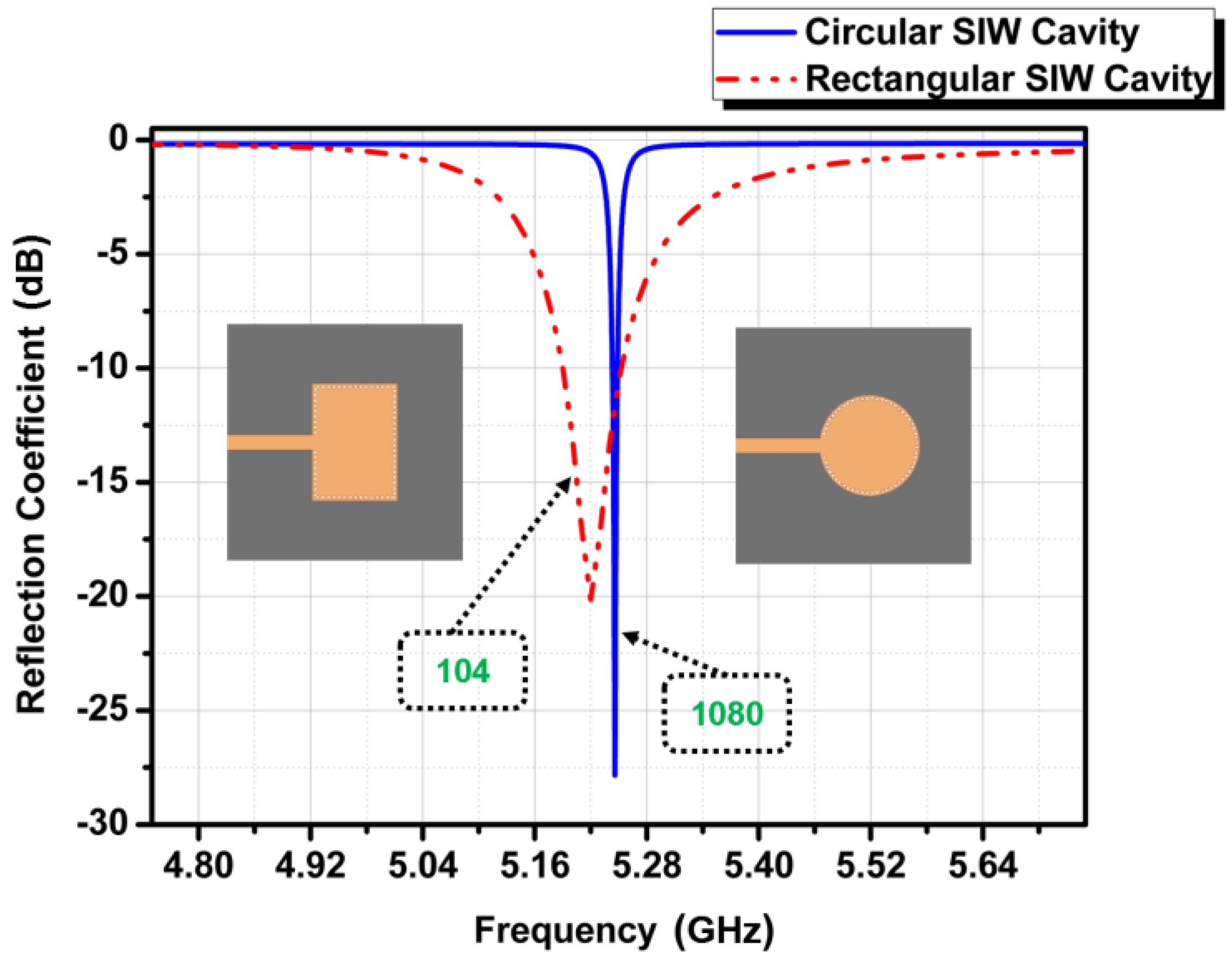
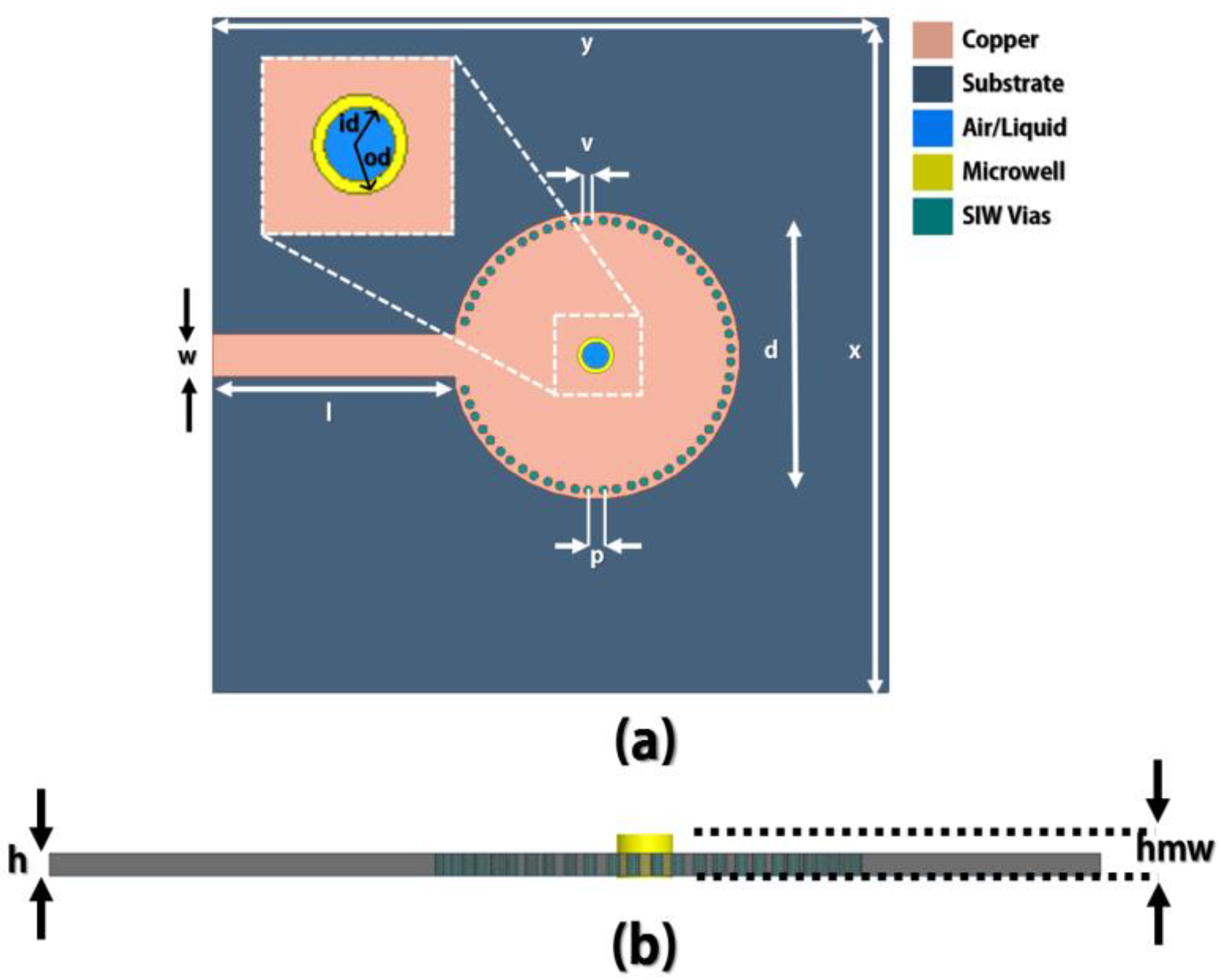

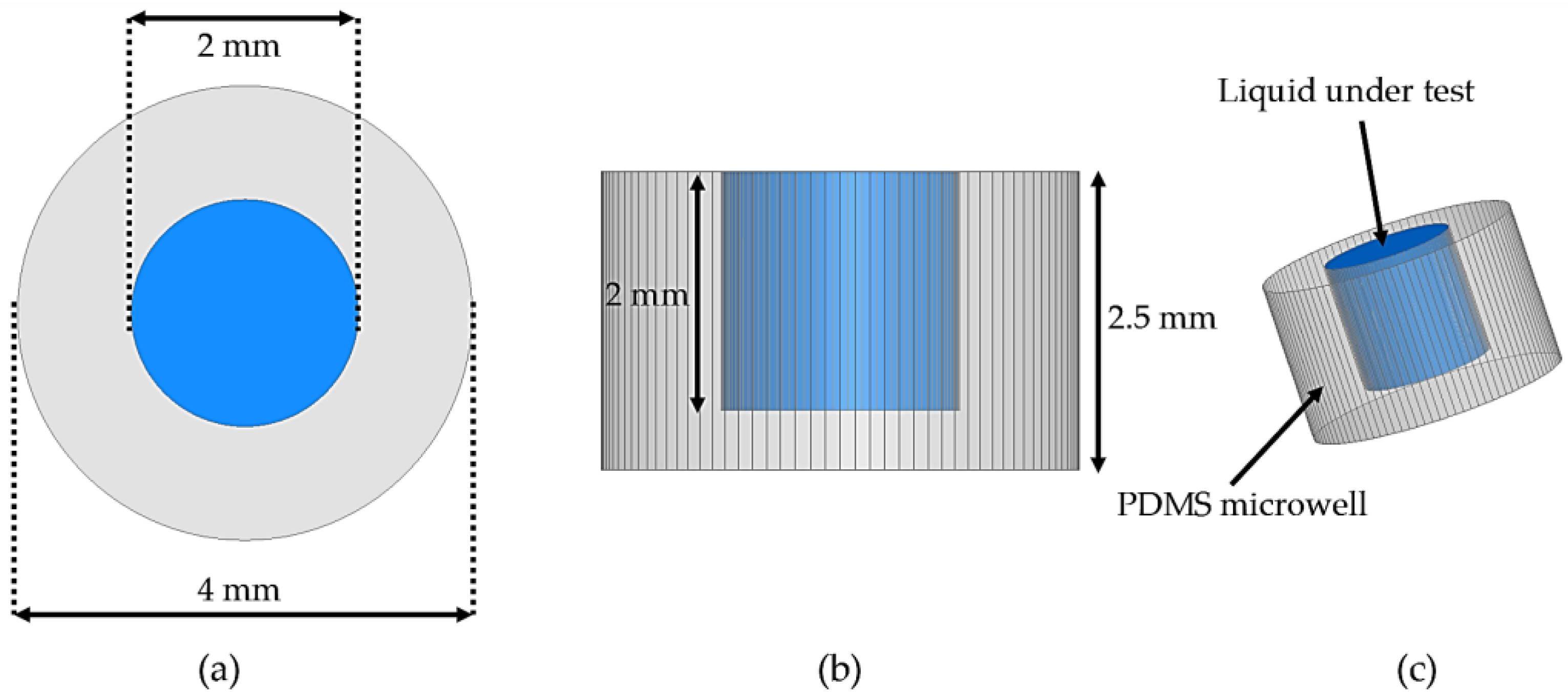
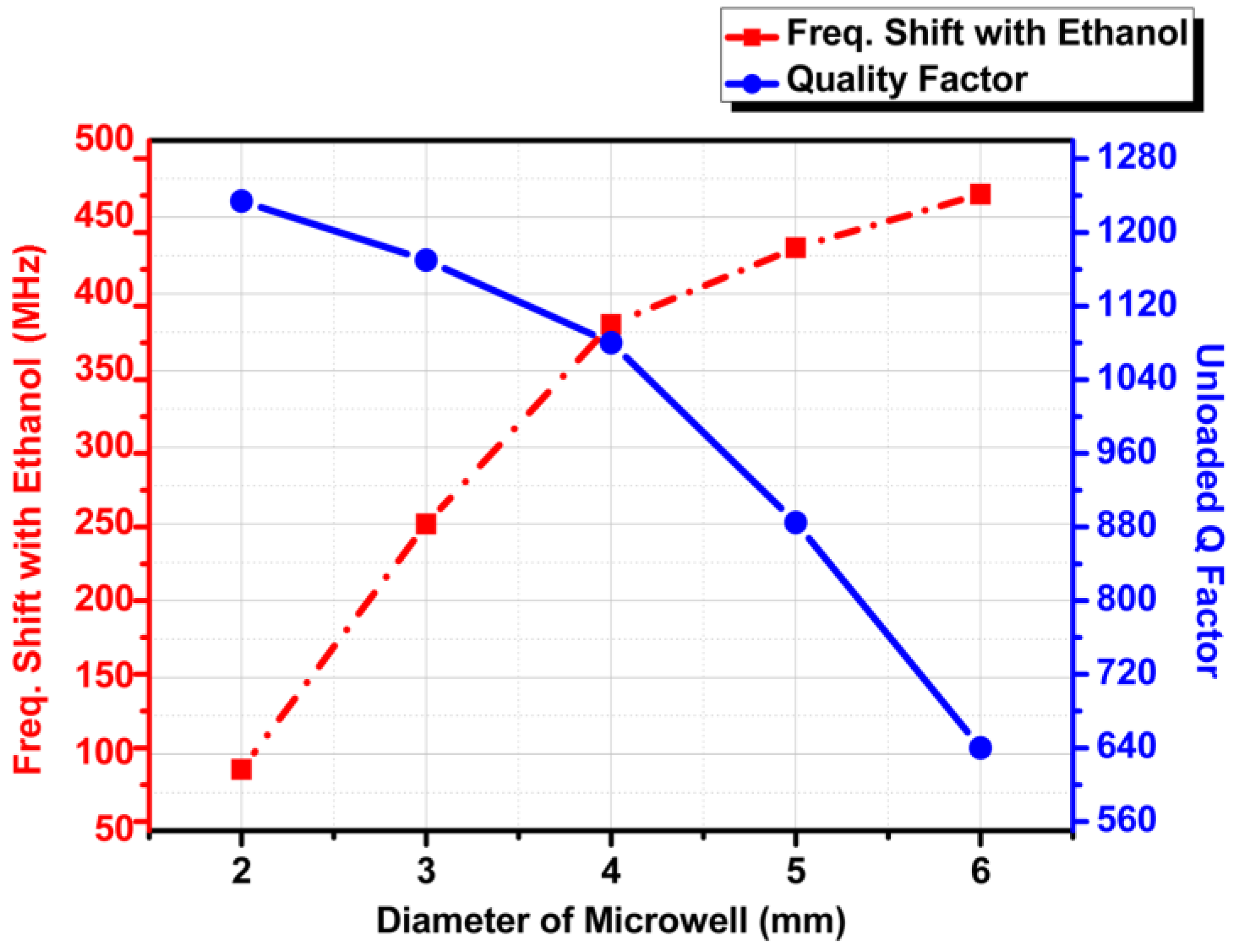

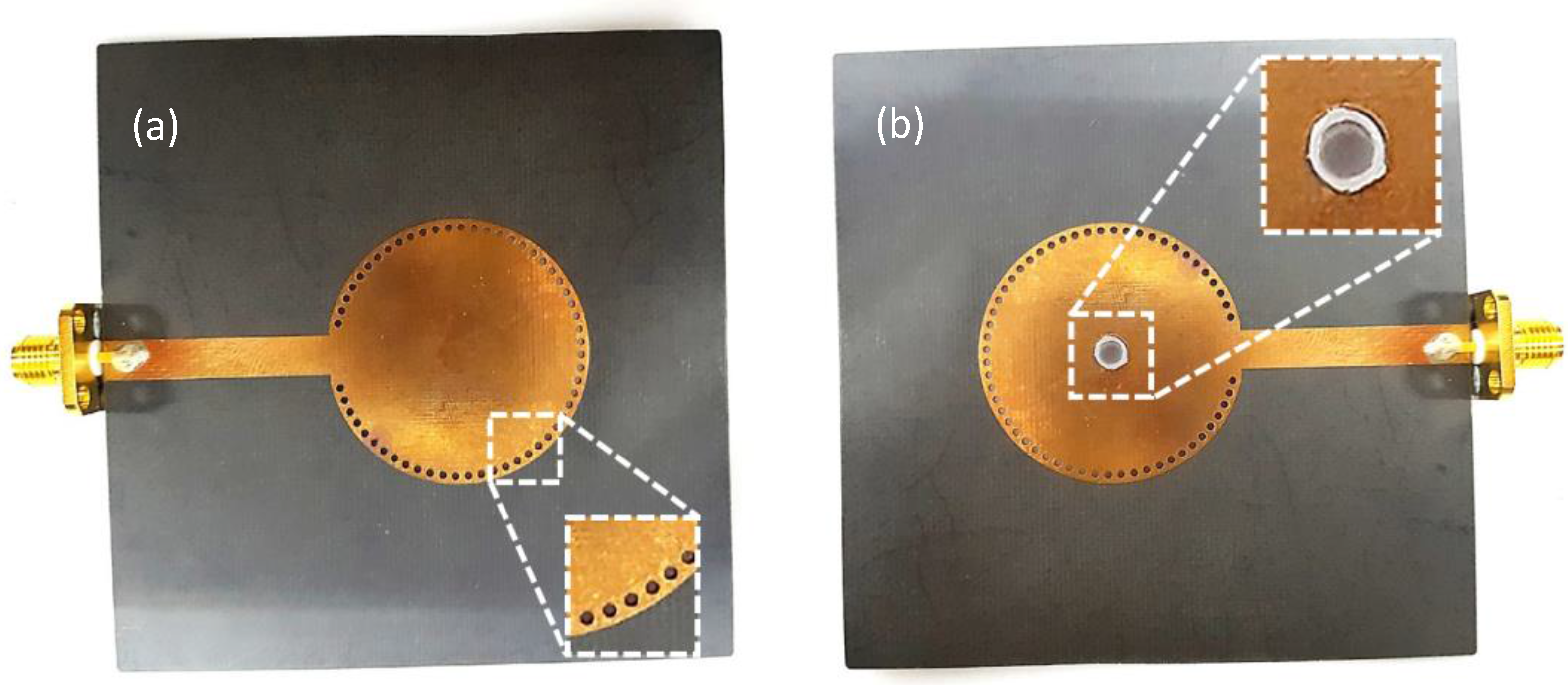
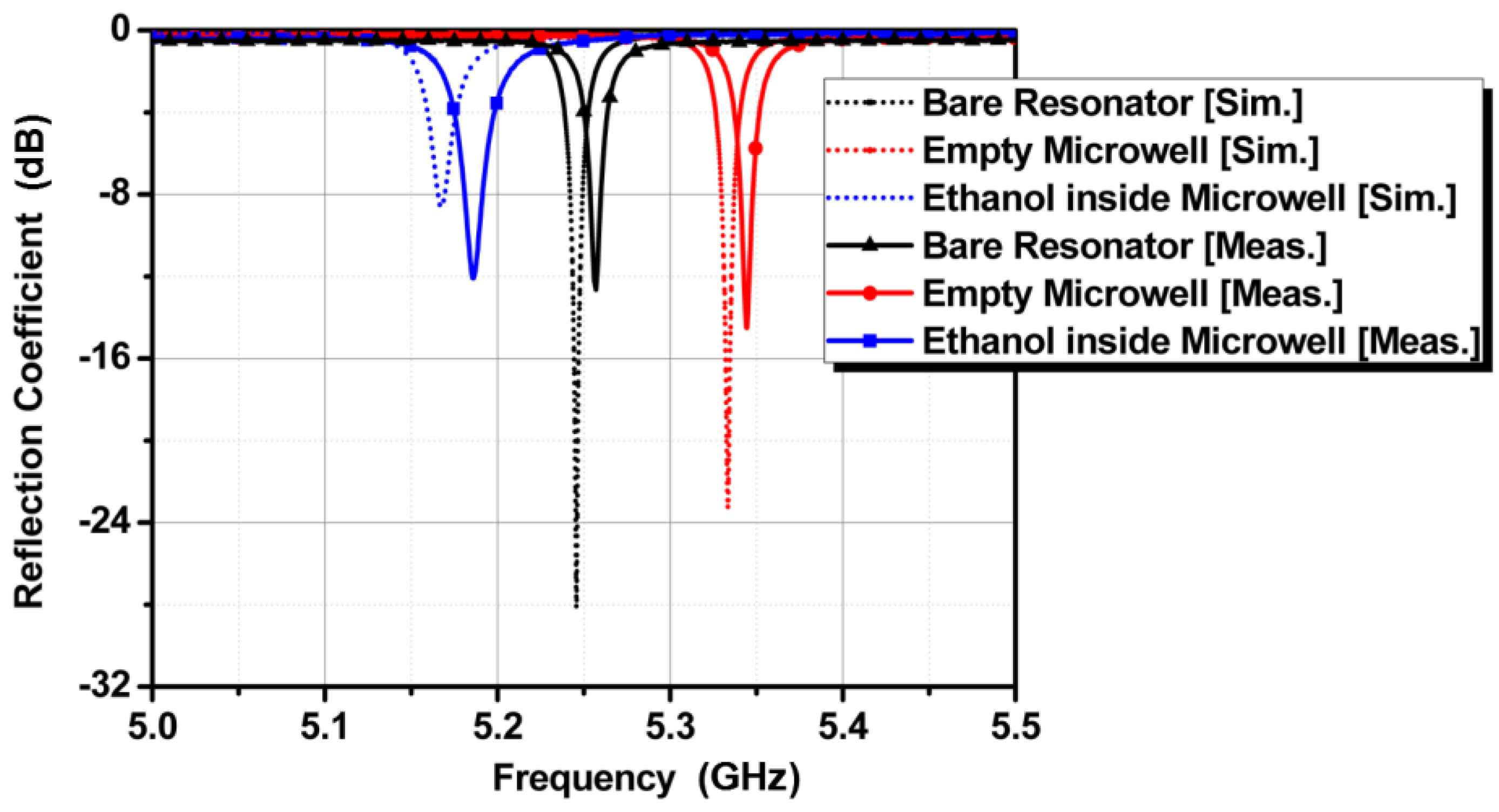
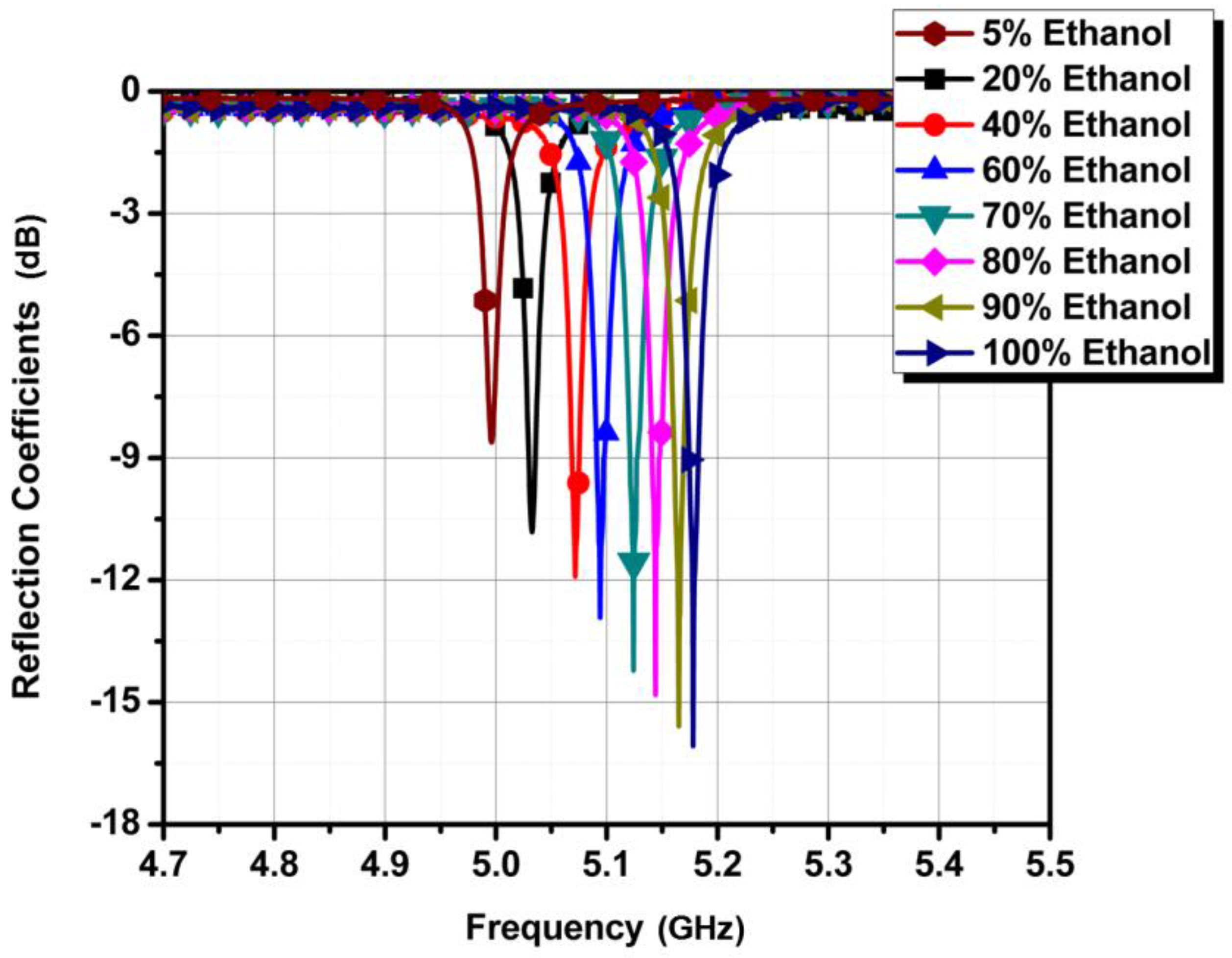
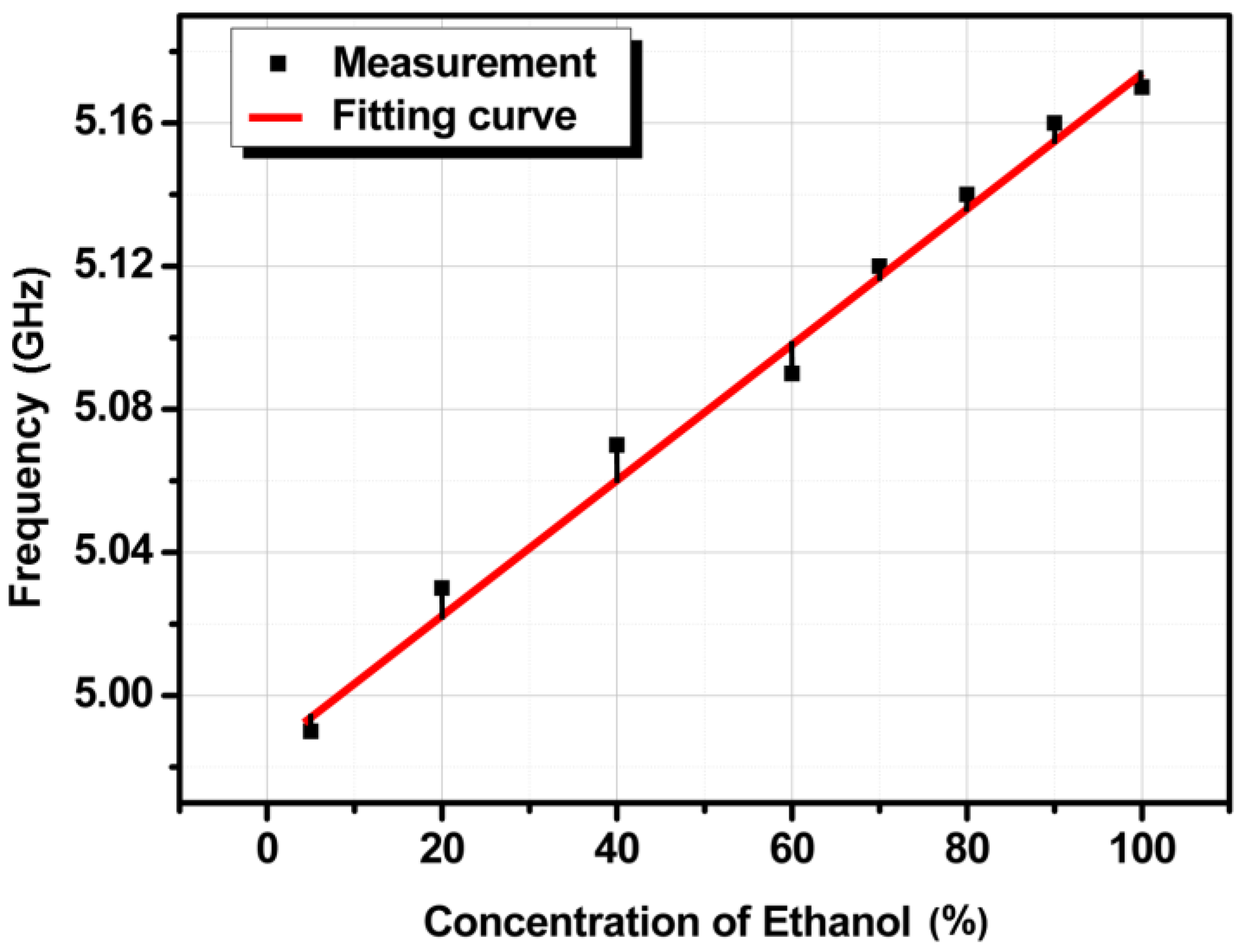

| Number | Parameter | Dimension (mm) | Description |
|---|---|---|---|
| 1 | x | 75 | Width of substrate and metallic bottom ground |
| 2 | y | 75 | Height of substrate and metallic bottom ground |
| 3 | l | 27 | Length of microstrip line feeding |
| 4 | w | 4.75 | Width of microstrip line feeding |
| 5 | d | 32 | Diameter of circular SIW patch |
| 6 | p | 1.7 | Pitch (center to center) distance between vias |
| 7 | v | 0.45 | Diameter of SIW vias |
| 8 | id | 2 | Inner diameter of microwell |
| 9 | od | 4 | Outer diameter of microwell |
| 10 | h | 1.575 | Height of Rogers substrate |
| 11 | hmw | 2.5 | Height of microwell |
| Reference | Sensing | Frequency Shift (∆f) ǂ (MHz) | Sensitivity (MHz/εr) | Technology | QF | Volume (μL) |
|---|---|---|---|---|---|---|
| [21] | Ethanol liquid | 145 | 26.36 | SIW | 39.12 | 10 |
| [34] | Ethanol liquid | 70 | 12.73 | SIW | 51 | 1 |
| [37] | Ethanol liquid | 38 | 5.84 | SIW | 334.6 | 500,000 |
| This work | Ethanol purity | 380 | 69.07 | Circular SIW | 1080 | 3 |
© 2018 by the authors. Licensee MDPI, Basel, Switzerland. This article is an open access article distributed under the terms and conditions of the Creative Commons Attribution (CC BY) license (http://creativecommons.org/licenses/by/4.0/).
Share and Cite
Memon, M.U.; Lim, S. Microfluidic High-Q Circular Substrate-Integrated Waveguide (SIW) Cavity for Radio Frequency (RF) Chemical Liquid Sensing. Sensors 2018, 18, 143. https://doi.org/10.3390/s18010143
Memon MU, Lim S. Microfluidic High-Q Circular Substrate-Integrated Waveguide (SIW) Cavity for Radio Frequency (RF) Chemical Liquid Sensing. Sensors. 2018; 18(1):143. https://doi.org/10.3390/s18010143
Chicago/Turabian StyleMemon, Muhammad Usman, and Sungjoon Lim. 2018. "Microfluidic High-Q Circular Substrate-Integrated Waveguide (SIW) Cavity for Radio Frequency (RF) Chemical Liquid Sensing" Sensors 18, no. 1: 143. https://doi.org/10.3390/s18010143





